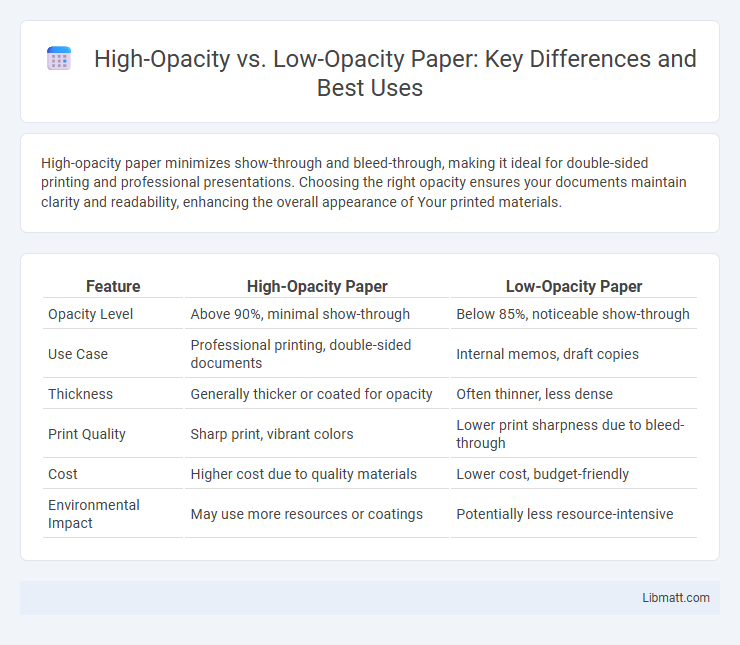High-opacity paper minimizes show-through and bleed-through, making it ideal for double-sided printing and professional presentations. Choosing the right opacity ensures your documents maintain clarity and readability, enhancing the overall appearance of Your printed materials.
Table of Comparison
| Feature | High-Opacity Paper | Low-Opacity Paper |
|---|---|---|
| Opacity Level | Above 90%, minimal show-through | Below 85%, noticeable show-through |
| Use Case | Professional printing, double-sided documents | Internal memos, draft copies |
| Thickness | Generally thicker or coated for opacity | Often thinner, less dense |
| Print Quality | Sharp print, vibrant colors | Lower print sharpness due to bleed-through |
| Cost | Higher cost due to quality materials | Lower cost, budget-friendly |
| Environmental Impact | May use more resources or coatings | Potentially less resource-intensive |
Introduction to Paper Opacity
Paper opacity measures the amount of light that passes through a sheet, affecting print clarity and readability. High-opacity paper prevents ink show-through and supports double-sided printing by blocking background interference. Low-opacity paper allows more light to pass through, which may cause text and images on the reverse side to be visible, reducing overall print quality.
Defining High-Opacity and Low-Opacity Paper
High-opacity paper refers to paper that minimizes light transmission, ensuring printed content remains sharp and images do not show through to the other side. Low-opacity paper allows more light to pass through, making content on the opposite side more visible and potentially causing readability issues. Opacity levels are critical in selecting paper for double-sided printing, with high-opacity sheets preferred for professional documents and marketing materials to enhance clarity.
How Opacity Affects Print Quality
High-opacity paper reduces show-through and improves print clarity by minimizing light transmission, resulting in sharper images and more vibrant colors. Low-opacity paper allows more light to pass through, increasing the risk of ink bleed and ghosting, which diminishes overall print quality. Choosing paper with appropriate opacity is essential for professional documents, ensuring optimal legibility and visual impact.
Key Applications for High-Opacity Paper
High-opacity paper is essential in printing applications where preventing show-through is critical, such as in book publishing, catalog production, and double-sided brochures. Its dense composition ensures crisp, clear text and vibrant images on both sides without bleed-through, enhancing readability and overall presentation quality. Your printed materials will benefit from the professional appearance and durability that high-opacity paper provides, especially for documents with intensive graphic content or thin paper grades.
Ideal Uses for Low-Opacity Paper
Low-opacity paper is ideal for applications requiring minimal show-through, such as double-sided printing, newspapers, and textbooks where readability on both sides is crucial. It is commonly used in lightweight, economical printing materials to enhance text clarity without increasing paper thickness. This makes low-opacity paper a preferred choice for mass-produced documents and materials needing high-quality, legible prints on both sides.
Cost Considerations: High vs Low Opacity
High-opacity paper generally costs more due to its enhanced thickness and reduced light transmission, which improves print quality and prevents image show-through. Low-opacity paper is often less expensive and suitable for everyday printing where bleed-through is not a major concern. Your choice depends on balancing budget constraints with the desired print appearance and functionality.
Environmental Impact of Different Opacity Levels
High-opacity paper typically uses more fibers and fillers, resulting in increased resource consumption and higher environmental footprint during production. Lower-opacity paper requires fewer raw materials, which can reduce energy use, water consumption, and emissions, promoting a more eco-friendly manufacturing process. Choosing the right opacity level for your printing needs can help minimize waste and support sustainable paper sourcing.
Opacity and Double-Sided Printing
High-opacity paper offers superior opacity, minimizing show-through and enhancing the clarity of double-sided printing, making it ideal for professional documents and books. Low-opacity paper allows more light to pass through, often resulting in visible text from the opposite side, which can reduce readability and print quality. Choosing higher opacity paper significantly improves the appearance and usability of double-sided printed materials by preventing interference between front and back content.
Choosing the Right Opacity for Your Project
High-opacity paper ensures minimal show-through, making it ideal for double-sided printing or projects requiring vibrant color reproduction. Low-opacity paper allows more light to pass through, often used for lightweight materials or when a translucent effect is desired. Understanding the opacity level helps you select the perfect paper to enhance your project's visual quality and functionality.
Conclusion: High-Opacity vs Low-Opacity Paper
High-opacity paper provides superior print clarity and reduces show-through, making it ideal for double-sided documents and high-quality presentations. Low-opacity paper is typically more cost-effective and sufficient for single-sided printing or materials where bleed-through is less critical. Choosing between high-opacity and low-opacity paper depends on the intended use, balancing quality requirements with budget constraints.
High-opacity paper vs low-opacity paper Infographic

 libmatt.com
libmatt.com